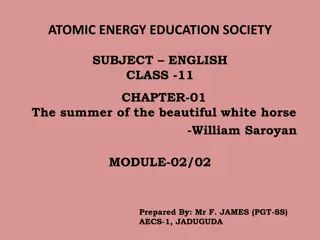Exploring Earth's Geologic Time and Extinction Events
Geologic Time reveals the Earth's 4.54 billion-year history through fossils, rocks, and ice cores. The Geologic Timescale provides insights into the planet's past, showcasing diverse life forms and major evolutionary events. Extinction events, both gradual and rapid, shape eras in Earth's timeline, with mass extinctions leaving lasting impacts. Understanding these concepts enriches our knowledge of Earth's geological and biological history.
Download Presentation

Please find below an Image/Link to download the presentation.
The content on the website is provided AS IS for your information and personal use only. It may not be sold, licensed, or shared on other websites without obtaining consent from the author. Download presentation by click this link. If you encounter any issues during the download, it is possible that the publisher has removed the file from their server.
E N D
Presentation Transcript
Chapter 17 How we Study the Earth
Geologic Time Geologic Time is the time in terms of the Earth s history of the Earth. Scientists now believe that the Earth is 4.54 billion years old. The information found in fossils, rocks, and ice cores have given scientists insight into the Earth s history. Fossils are the recognizable remains or impressions of an organism that lived in the past.
Geologic Time (CONT) The Geologic Timescale is a calendar of Earth s history. It is based mostly on fossil evidence found in rocks and ice cores. The Geologic Timescale covers a very long time period and it shows the diversity of Earth s past and the organisms that have lived and died over different periods based on the fossil evidence of mass extinctions. Scientists use tools and dating techniques to construct a picture of the past and to study climate, landforms, geologic events and organisms.
Geologic Timescale Era Period Millions of Years Ago Major Evolutionary Events Cenozoic Quaternary Tertiary 2 65 Early Humans First placental mammals (rats) Mesozoic Cretaceous Jurassic Triassic 135 180 230 Flowering plants First birds/mammals First dinosaurs Palezoic Permian Carboniferous Devonian Silurian Ordovician Cambrian 286 320 405 425 505 545 Conifers dominant First reptiles First amphibians Land plants/animals First fishes Invertebrates Precambrian 2000 Life diversifies 3000 3500 Eukaryotes Prokaryotes Live evolves
Divisions of Time Eons: 2 or more periods. The largest division of time in the Geologic Timescale Era: 2 or more periods Period: 2 or more epochs Epoch: smallest division of time in the geologic timescale.
Extinction Scientists will sometimes define eras based on the extinction of a species. Extinction occurs when the last organism of a species dies. Causes of extinction: increased competition for resources, human interaction, climate change, loss of food, increased predation, disease or habitat loss. Extinction: can be a slow or fast
Extinction (cont) A mass extinction occurs when a large percentage of the organisms on Earth go extinct. These are usually a fast process (couple of 1000 of years). Last one occurred about 65 million years ago and led to the destruction of the dinosaurs.
The Fossil Record Fossils can be also useful in studying geologic time. A fossil is the recognizable remains or body impressions of an organism that lived in the past. The fossil record refers to all fossils that have been found since the study of fossils began. Some fossils are recognized as unique to a certain time period, this is called an index fossil.
The fossil record (Cont) When an index fossil is found in sedimentary rock, the age of the rock is assumed to be the same as the age of the fossil. Formation of fossils: most fossils come from organisms that have hard body parts like bones and shells. These bones and shells will fossilize easier than soft body parts. Fossils are more likely to form when animals are buried very quickly. Only occasionally are conditions right to form fossils.
Formation of fossils cont Catastrophic events like floods, mudslides, earthquakes, and ask deposition from volcanoes usually lead to the formation of fossils. It is believed that fossils only make up about .1% of all organisms that have lived on the planet.
Types of fossils 1. Mold: When all that is left is an organism- shaped hole in the rock. 2. A cast or internal mold is formed when sediments or minerals fill the internal cavity of an organism.
Types of fossils (Cont) 3. Body fossils: when you have a fossil of the whole body usually happens with insects found in amber. This is a very rare type. 4. Trace fossils: footprints, bite marks, and excrement left by an organism. This is the most common type.
The Age of Geologic Events Scientists use techniques that allow them to read the rock deposits in the sedimentary rock layers. How and when a geologic event occurred can be determined in a number of ways. Relative dating and absolute dating are 2 techniques used to determine the age of rocks. Scientists use the techniques along with ice core data, volcanic eruption and climate changes to put the geologic events in a logical sequence.
Relative Dating When it come to rock strata (layers of sedimentary rock), each layer is older than the layer above it. Layers get older as you go downward. This kind of dating is called relative dating because it allows you to know the order in which the layers were formed but not the actual age. Law of superposition: states that each sedimentary rock unit is older than the rock unit above it and younger than the unit below it.
Relative Dating (CONT) Sometimes the layers of rock and sediment are not laid down continuously. A break in the sedimentary geologic record is known as unconformity.
Absolute Dating In absolute dating, scientists use the natural decay of radioactive isotopes (special types of atoms that fall apart on predictable timescales). The unstable isotopes, called radioactive parents, decay to form other more stable elements called daughter products. The calculation of the ratio of parent to daughter products is called radiometric dating. The time it takes for one half of the original, unstable atom to decay into a daughter product is called a half-life.
Absolute Dating (Cont) Example of half-life Let s say a rock layer contains a million atoms of the parent isotope with a half-life of 5 million years. At this point the number of daughter products is zero because decay has not occurred. At the end of 5 million years, half of the parent isotopes will decay or change into daughter products. So you will have 500,000 parent isotopes and 500,000 daughter products. After 5 million more years, how many parent isotopes and daughter products will you have?
Ice Cores The glaciers and polar ice caps contain the majority of fresh water on Earth. Massive amounts of snow fall on Antarctica each year and the snow brings with it particles of matter contained within the Earth s atmosphere at the time of precipitation. This means that ice sheets contain another sort of geological record.
Ice cores (CONT) Ice cores are taken to extract information contained within the ice sheets. They are long cylinders of ice obtained from glaciers and ice sheets by a cutting device. Scientists looks for trends and changes in temps in the ice cores. They measure the levels of certain atmospheric components. They use this data to make conclusions about climate patterns, geological events and the more recent effects of human activity. They compare the data collected from all around the world.
Volcanic Eruptions Sulfates found in ice cores are used to determine the intensity and timing of volcanic eruptions. Volcanic eruptions spew ash and sulfuric gases into the atmosphere. This blocks out sunlight and lowers temps worldwide. Ice cores are one way that scientists can determine the occurrence and impact of volcanic eruptions. Another way is to identify the layer of volcanic ash in the rock layers with the fossils and look for changes in the fossil record.
Climate Variability Climate change is a term to describe significant long-term changes in Earth s climate. Earth s climate has changed many times over the past. Studying past climates can help scientists determine how humans may be influencing the climate today. Global warming is part of a natural Earth warming that is called the greenhouse effect. The greenhouse effect traps solar heat within the Earth s atmosphere.
Greenhouse effect (cont) Humans have altered this natural warming cycle. Global warming is the term used to describe the measured rise in the Earth s temps. It describes the changes in modern climate. It comes from a rise in greenhouse gases.























